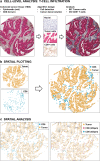Precision immunoprofiling by image analysis and artificial intelligence
- PMID: 30470933
- PMCID: PMC6447694
- DOI: 10.1007/s00428-018-2485-z
Precision immunoprofiling by image analysis and artificial intelligence
Abstract
Clinical success of immunotherapy is driving the need for new prognostic and predictive assays to inform patient selection and stratification. This requirement can be met by a combination of computational pathology and artificial intelligence. Here, we critically assess computational approaches supporting the development of a standardized methodology in the assessment of immune-oncology biomarkers, such as PD-L1 and immune cell infiltrates. We examine immunoprofiling through spatial analysis of tumor-immune cell interactions and multiplexing technologies as a predictor of patient response to cancer treatment. Further, we discuss how integrated bioinformatics can enable the amalgamation of complex morphological phenotypes with the multiomics datasets that drive precision medicine. We provide an outline to machine learning (ML) and artificial intelligence tools and illustrate fields of application in immune-oncology, such as pattern-recognition in large and complex datasets and deep learning approaches for survival analysis. Synergies of surgical pathology and computational analyses are expected to improve patient stratification in immuno-oncology. We propose that future clinical demands will be best met by (1) dedicated research at the interface of pathology and bioinformatics, supported by professional societies, and (2) the integration of data sciences and digital image analysis in the professional education of pathologists.
Keywords: Artificial intelligence; Digital pathology; Image analysis; Immuno-oncology; Immunotherapy; Machine learning; Personalized medicine.
Conflict of interest statement
KS and JR have no relevant affiliations or financial involvement with any organization or entity with a financial interest in or financial conflict with the subject matter or materials discussed in the manuscript. This includes employment, consultancies, honoraria, stock ownership or options, expert testimony, royalties, or patents received or pending. V.H.K. and K.D.M. are participants of a patent application co-owned by the Netherlands Cancer Institute (NKI-AVL) and the University of Basel on the assessment of cancer immunotherapy biomarkers by digital pathology. Based on NKI-AVL and the University of Basel policy on management of intellectual property, V.H.K. and K.D.M. would be entitled to a portion of received royalty income. V.H.K. has served as an invited speaker on behalf of Indica Labs.
Figures


References
-
- Directive 98/79/EC of the European Parliament and of the Council of 27 October 1998 on in vitro diagnostic medical devices. https://ec.europa.eu/growth/single-market/european-standards/harmonised-.... Accessed March 6th, 2018
-
- Roche receives FDA clearance for the VENTANA MMR IHC panel for patients diagnosed with colorectal cancer. http://www.ventana.com/roche-receives-fda-clearance-ventana-mmr-ihc-pane.... Accessed May 14th, 2018
-
- U.S. Department of Health and Human Services, Food and Drug Administration, Center for Devices and Radiological Health, Office of In Vitro Diagnostics and Radiological Health, Division of Molecular Genetics and Pathology MP and CB. [Internet]. Technical performance assessment of digital pathology whole slide imagingdevices; 2016. Available from: http://www.fda.gov/downloads/MedicalDevices/DeviceRegulationandGuidance/.... Accessed March 7th, 2018
-
- Alexandrov LB, Nik-Zainal S, Wedge DC, Aparicio SA, Behjati S, Biankin AV, Bignell GR, Bolli N, Borg A, Borresen-Dale AL, Boyault S, Burkhardt B, Butler AP, Caldas C, Davies HR, Desmedt C, Eils R, Eyfjord JE, Foekens JA, Greaves M, Hosoda F, Hutter B, Ilicic T, Imbeaud S, Imielinski M, Jager N, Jones DT, Jones D, Knappskog S, Kool M, Lakhani SR, Lopez-Otin C, Martin S, Munshi NC, Nakamura H, Northcott PA, Pajic M, Papaemmanuil E, Paradiso A, Pearson JV, Puente XS, Raine K, Ramakrishna M, Richardson AL, Richter J, Rosenstiel P, Schlesner M, Schumacher TN, Span PN, Teague JW, Totoki Y, Tutt AN, Valdes-Mas R, van Buuren MM, van ‘t Veer L, Vincent-Salomon A, Waddell N, Yates LR, Australian Pancreatic Cancer Genome I, Consortium IBC, Consortium IM-S, PedBrain I. Zucman-Rossi J, Futreal PA, McDermott U, Lichter P, Meyerson M, Grimmond SM, Siebert R, Campo E, Shibata T, Pfister SM, Campbell PJ, Stratton MR. Signatures of mutational processes in human cancer. Nature. 2013;500:415–421. doi: 10.1038/nature12477. - DOI - PMC - PubMed
Publication types
MeSH terms
Substances
Grants and funding
LinkOut - more resources
Full Text Sources
Other Literature Sources
Research Materials
Miscellaneous

